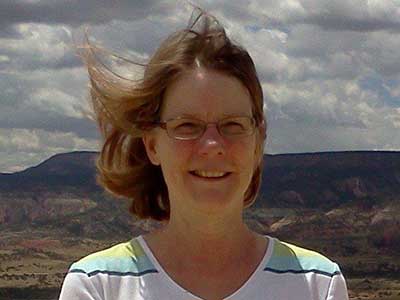In the midst of increasing chaos caused by climate change, from devastating hurricanes to deadly polar vortexes, the literary genre of climate fiction offers stories that capture our anxieties, broaden our scope of empathy to people experiencing disaster in far-flung places and even point the way to hopeful futures where we’ve responded to climate chaos with ingenuity and compassion.
Arizona State University's 2018 Everything Change Climate Fiction Contest challenged writers from around the world to submit stories that provided glimpses of the consequences of climate change on the ground, for actual people in specific places. Climate change is both multifarious and monolithic: It makes itself known differently in different places, but it’s also one big thing that we’re all living through. Fiction can be a powerful way to make climate change and its effects visible and visceral.
The contest’s winner is Barbara Litkowski of Zionsville, Indiana, who wrote “Monarch Blue,” a thrilling story that’s both elegiac about what we’ve lost as a result of environmental degradation and angry about how climate chaos deepens existing inequalities around race, gender, social class and national origin. The story appears in "Everything Change: An Anthology of Climate Fiction, Volume II," alongside nine other pieces of short fiction, along with a foreword from renowned science fiction author Kim Stanley Robinson, who served as the lead judge for the contest.
Robinson has referred to the current climate predicament as the “emergency century,” a historical moment that demands decisive, coordinated action to avert a crisis that threatens both human civilization and Earth’s entire biosphere. The editors of "Everything Change," Angie Dell and Joey Eschrich, argue in the anthology’s introduction that stories are a crucial tool in the face of this global challenge: “To achieve the cultural groundswell and political momentum to change ourselves in the face of a changing climate, we need stories.”
Download the anthology, along with an entire list of winners.
Litkowski, who holds an MFA in creative writing from Butler University and has published fiction in a variety of venues, including Subtle Fiction and Blue Lake Review, says that “personalizing abstract issues” like climate change “makes them more relatable and, consequently, more actionable.”
The 2018 contest, ASU’s second, received 540 submissions from more than 60 countries. Winners were selected through a multistage judging process involving a variety of ASU experts, in disciplines ranging from history, political science and creative writing to sustainability and oceanography.
Among the contest’s finalists was Leah Newsom, an MFA candidate in fiction at ASU and outreach coordinator for the Arizona Center for Medieval and Renaissance Studies. Her story, “Orphan Bird,” considers the effects of environmental pollution and climate change both on California’s Salton Sea and on women’s bodies, through the eyes of a young woman who is pregnant, surveying a mostly forgotten and bleak landscape decimated by human activity and mismanagement.
The contest and the anthology are presented by ASU’s Imagination and Climate Futures Initiative, a partnership of the Center for Science and the Imagination and the Virginia G. Piper Center for Creative Writing.

Barbara Litkowski, winner of the 2018 Everything Change Climate Fiction Contest, is shown near Chimney Rock.
Litkowski talked more with ASU Now about the inspiration behind “Monarch Blue,” the social and political impact of climate fiction and hope in the face of disaster.
Question: What inspired you to write “Monarch Blue”?
Answer: Ever since Colony Collapse Disorder (CCD) began threatening honeybee colonies, I’ve been concerned about the vulnerability of our insect population. One of the first questions I asked when writing “Monarch Blue” was: What would happen if extreme temperatures and changing weather patterns disrupted delicate relationships between plants and pollinators? That question led to many more. How would ordinary people respond to food shortages? How would agricultural production adapt? And so on.
The monarch butterfly image comes from my childhood. My sister was an avid butterfly collector, and she and I would roam the woods behind our house netting skippers, monarchs and, if we got lucky, a swallowtail or two. Monarchs were more common then. Good specimens were sealed in a killing jar that had a cotton ball, drenched in poison, taped to the lid. By morning, the butterflies’ wings and legs were so stiff they needed to be chemically relaxed for mounting.
Q: The story weaves together climate change with issues of gender, immigration and labor. For you, how does climate chaos relate to social inequality?
A: Last year when I was writing “Monarch Blue,” I was also teaching a first-year seminar at Butler University called “Poverty in America.” So naturally, I began to speculate on how climate change might increase social and economic inequality. Two documentaries that highlight the plight of seasonal workers, "Harvest of Shame" and "Food Chain$," had a big impact on the way I portrayed migrant life.
It’s an uncomfortable fact that a disproportionate number of single mothers and minorities live in poverty. It’s also sad but true that single mothers and minorities often work at low-paying, unskilled jobs. Project these statistics into the “Monarch Blue” future and you’ll find “tumbleweed women,” willing to risk carcinogenic contamination and infertility to feed their families. Only Brie, a runaway with affluent, supportive parents, has any chance of upward mobility.
Q: “Monarch Blue” takes place in the southwest United States. Have you ever spent any time in this part of the country? Did you do any special research about the geography, climate and culture of the region?
A: Although I was born in San Diego, I grew up in the Midwest. A road trip through Texas, New Mexico, Arizona and California provided the contrasting visual images I used in my settings: dying towns and flourishing orchards, gritty parking lots and endless rows of fruit and nut trees.
Most of my research involved looking up different types of edible plants and reading about their reproductive habits — I always try to make my stories as realistic as I can. I also collected random information — now in a mental file folder labeled “Things I Hope I Never Need to Know” — on topics like how to operate a bucket truck.
Q: Climate change is a visceral experience in the story: bodies wracked and skin stained by chemical exposure, our agricultural system and food supply under threat. What were you hoping to communicate to readers about the effects of climate change on our bodies and health?
A: I suppose I’m trying to convey what esteemed science fiction writer, Margaret Atwood, calls “everything change,” the idea that climate change affects all aspects of human existence: economies, social relationships and even health and diet. I chose visceral images to illustrate some potential biological risks, specifically contamination and malnutrition. I also used food imagery to highlight potential cultural risks. Brie has vivid memories of holiday feasts and dreams about pies that are no longer possible. Lastly, I used food to show how we relate to other people. Some of us hide our Halloween candy; others, like Brie’s friend Carmen, share their corn tortillas.
Q: Why do you write climate fiction? Do you believe that reading fiction can motivate people to change their thinking about climate change, or become more active on the issue?
A: I write about people struggling to overcome obstacles. In “Monarch Blue” those obstacles arise as a result of climate change.
It’s often said that personalizing abstract issues makes them more relatable and, consequently, more actionable. Two works, "Evicted: Poverty and Profit in the American City" by Matthew Desmond and "$2.00 a Day: Living on Almost Nothing in America" by Kathryn Edin and Luke Shaefer, come immediately to mind as excellent examples of narrative nonfiction. Each demonstrates the power of storytelling to influence public opinion and promote political action. In the same way, I think insightful fiction, especially thoughtful science fiction and its subgenre, climate fiction, can change lives by depicting dangerous future scenarios and motivating ordinary people to work together to solve them.
Q: What’s next for you? Do you have any new stories or books in the works?
A: I’m always thinking about stories, writing stories or, as people who know me well often complain, rewriting stories. Some of my ongoing projects include a short-story collection and novel about an 8-year-old cryptozoologist.
Q: Are there reasons to be hopeful, in the face of escalating climate chaos?
A: Recent reports on the state of our global environment are grim, and I find it hard not to feel frustrated and powerless when I read them. However, data collected by the Yale Program on Climate Change Communication offer glimmers of hope. More than 70 percent of respondents to Yale’s 2018 survey see global warming as a threat to plants and animals and future generations, and an even greater percentage support selected policies to combat or retard climate change.
One of the best pieces of news I’ve heard so far this year comes from Mexico’s national commissioner for protected natural areas, who reports that the population of monarch butterflies wintering in central Mexico is up 144 percent. So, yes, I trust in a future where clearheaded people, everywhere, join forces to stop environmental degradation.
Top illustration by Matt Phan/Center for Science and the Imagination
More Environment and sustainability

ASU prof turns trash into treasure
The Research Corporation for Science Advancement, or RCSA, regularly hosts a series of discussions known as Scialog, a portmanteau of science and dialogue. Created in 2010, the Scialog format…

Best outdoor experiences are shared and build connections, recreation professor says
Steve Sassaman doesn’t really need to tell you he’s an outdoorsman. One look at his full, dark beard gives a vibe that clearly says he knows which end of the kayak to put into the water first.While…

ASU offers new project-based courses for global leaders of tomorrow
Addressing complex challenges requires innovative solutions.This is why the College of Global Futures — with its four academic units including the School for the Future of Innovation in Society, the…
